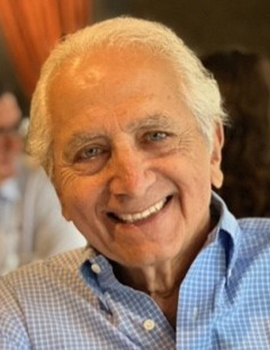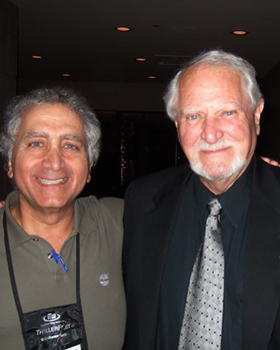

Features Gary Braver
Present-Day Murders Echo a Tragedy From the Past
The Big Thrill Interviews Gary Braver
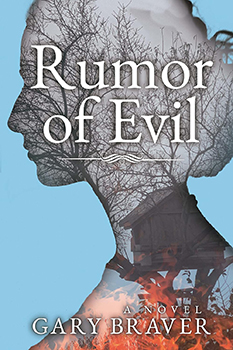 Twenty years ago, a beautiful, 16-year-old Slovakian girl spent the fall semester as an exchange student with Morgan Cassidy and her family at their Lexington, MA, home. Morgan and her friends Sylvie, Krista, and Riley nicknamed her Lulu and began showing her around their school and town. Although the teens found Lulu’s Romany background “different,” Morgan tried to help her fit in, until something terrible happened, and rumors of witchcraft began spreading.
Twenty years ago, a beautiful, 16-year-old Slovakian girl spent the fall semester as an exchange student with Morgan Cassidy and her family at their Lexington, MA, home. Morgan and her friends Sylvie, Krista, and Riley nicknamed her Lulu and began showing her around their school and town. Although the teens found Lulu’s Romany background “different,” Morgan tried to help her fit in, until something terrible happened, and rumors of witchcraft began spreading.
Now, Sylvie is found dead in the backyard of her Cambridge home. Homicide detective Kirk Lucien and his new partner, Mandy Wing, are called to investigate an apparent suicide, but there are intriguing clues of something much more sinister. As Kirk and Mandy dig deeper, and a second murder occurs, it will take all their skill to find the killer and unravel the mystery of the past.
RUMOR OF EVIL released this October. Lee Child calls it “a fine piece of work.” Steve Berry says, “All the right elements combine in this high stakes drama.”
The Big Thrill wanted to know more about author Gary Braver and this book, so we tracked him down to ask a few questions.
How did you begin writing fiction?
I wanted to write fiction in high school, but two uncles who were scientists influenced me to major in physics in college. Soon, I discovered I was better at manipulating words than atoms, so I became an English professor. I taught other writers’ works and got a feeling for how novels are written, all the while chomping at the bit to write my own. The problem was, I had no story.
But I found one. On a marine archaeological expedition off the island of Mallorca, modern-day pirates attacked a diving buddy and me while we were 30 feet below excavating a 2nd century BC Roman shipwreck. Unbeknownst to us, we had stumbled upon an international black-market operation, dealing in stolen antiquities. They tried to gaff us with pendant anchors pulled from the rear of a speedboat, hoping to pull us out to the deep. Luckily they failed, but I swore that if I escaped that experience alive, I’d write a book. I moved the locale to the Aegean island of Santorini, the source of Plato’s Atlantis legend, cranked up the drama, and four years later that experience became Atlantis Fire.
You shared an office with Robert B. Parker, and he became one of your closest friends. What was the most important thing you learned from him?
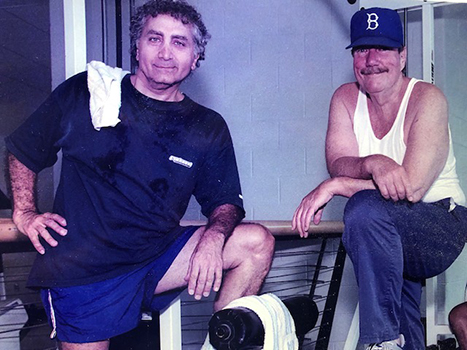
Gary and Robert Parker at the Northeastern University gym. Parker was Gary’s office mate and life-long friend.
© Gene C. Grzywna
Because his desk was a few feet from mine, I watched him write and publish his first four Spenser novels. He made it look easy, but perhaps the most important thing I learned from Bob Parker was to analyze other authors’ writings the way a carpenter looks at a house. In other words, study how they get in and out of scenes; how they economically create characters through action, dialogue, interior narratives; what they look like and wear; how they think in their interior narratives; how they express themselves in phrases that distinguish them from other characters. How they end chapters in cliffhangers to keep you turning the pages.
It’s the same advice I’ve been passing on to my writing students for over 40 years.
What draws you to the mystery/thriller genre?
When I was growing up, every Saturday my friends and I watched double features of science fiction, horror, western, and cops-and-robber movies. On a deep level, I absorbed the motifs, structures, and strategies of good mysteries and thrillers, as well as a cinematic imagination that informs my writing.
Studying for my doctorate in English literature, I was immersed in literary fiction. So, I wanted to employ the styles and strategies of celebrated novels—strong and layered characters, intellectually exciting stories, and good craft—not just plot-driven tales full of stereotypes.
In RUMOR OF EVIL, girls bully an exchange student, with disastrous consequences. What made you decide to use this as one of the themes of the story, and how did you connect it to the present-day murder?
For inspiration, I looked to my file of real criminal cases and found a case from 2014 in which two 12-year-old Wisconsin girls were arrested for the near-fatal stabbing of their 12-year-old friend to appease Slender Man—a cartoon character on the Internet. According to police, the two girls had convinced themselves that Slender Man would kill their families if they did not murder their friend.
I became fascinated by adolescent bullying. Bullies want to impress their peers, are aggressive, and have hot temperaments. They often have family problems that make them jealous of their victims, envious of their appearance, personality, skills. Bullies convince others to dislike those victims, effectively spreading the guilt.
The most common characteristic of a bullied victim is that he or she is “different” somehow—in appearance, behavior, background; or from a different social, ethnic, religious, or economic status; or is considered bad luck and friendless. In short, they are outsiders to the accepted adolescent “norm.”
Drawing from such characteristics, I created a dark-skinned, 16-year-old Romany exchange student, Vadima Lupescu. She comes to upscale Lexington, MA, from a rural Slovakian pig farm in uncool outfits, traditional Eastern European braids, and speaking English with an accent. She also has strange customs—e.g., taking off her shoes when entering a home and standing up when the teacher enters a classroom.
At first, the four girls have fun Americanizing her—buying her cool outfits at the mall, introducing her to peanut butter and jelly, Mexican food, and backyard barbeques, and getting rid of those braids. They also give her a cool nickname—Lulu.
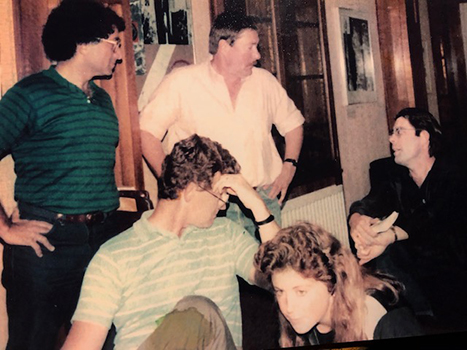
London Writers Workshop—Gary, Robert B. Parker, Stephen King, William Martin and unknown female student (left to right).
© Kathleen Goshgarian
She also can read palms and seemingly predict the future. I wanted to reflect the superstitious adolescent mindset, reminiscent of the paranoid young females who triggered the Salem witch trials of 1692. Centuries later, that dangerous phenomenon of bullying and scapegoating persists today.
So this backstory of the mysterious death of Vadima two decades ago connects to the staged suicide of Sylvie, the woman found hanging from a tree in her backyard in the opening chapter.
Kirk and Mandy have an interesting relationship as partners.
Kirk Lucian is a 21-year police veteran, estranged from his wife, and Mandy Wing, Kirk’s new partner, is married to another woman and the mother of a toddler. Kirk wishes to save his marriage, and Mandy seeks acceptance as a gay woman in a traditionally straight male profession.
Throughout their investigation, their personal challenges affect their professional quest to solve the case. For example, Kirk resists Mandy’s attempt to get him to date other women, and he tries to calm down Mandy’s knee-jerk urge to arrest men she suspects of wronging females.
How do the chapters in Morgan’s point of view enhance the story?
While Kirk and Mandy investigate the present-day murder, the juxtaposition to Morgan’s chapters creates growing connections while adding added layers of depth, irony, and suspense. And dark motives and red herrings.
What’s next for you?
My next novel is called Heat of the Moment, the second in the Kirk-and-Mandy series. A charismatic English professor who has offended five unrelated individuals is murdered. All of them have convincing motives for killing him.
The Big Thrill Interviews Gary Braver
- The Big Thrill Recommends: SERVED COLD by James L’Etoile - July 26, 2024
- The Big Thrill Recommends: THE PARIS VENDETTA by Shan Serafin - June 27, 2024
- The Big Thrill Recommends: THE GENERAL’S GOLD by LynDee Walker and Bruce Robert Coffin - April 25, 2024

